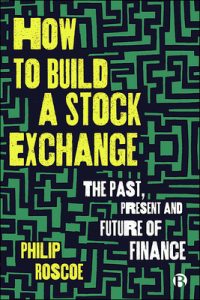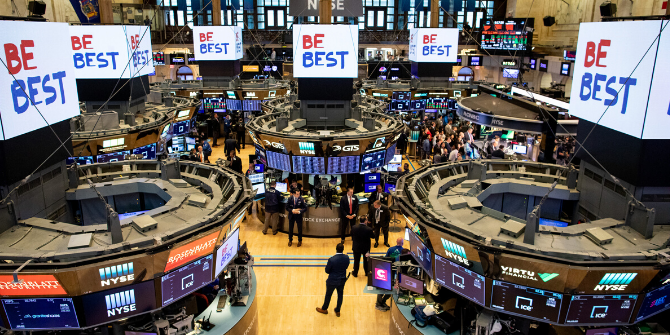In How to Build a Stock Exchange: The Past, Present and Future of Finance, Philip Roscoe unpacks the history and mechanics of the stock exchange and considers what may be in store for the future of finance. Seamlessly blending sociological analysis with lively anecdotes from his career as a financial reporter, Roscoe offers readers an engaging look at the inner workings of financial markets, writes Remi Meehan.
How to Build a Stock Exchange: The Past, Present and Future of Finance. Philip Roscoe. Bristol University Press. 2023.
 Far from a dull manual on the technical aspects of stock exchange building, Philip Roscoe’s How to Build a Stock Exchange presents a delightfully readable and engaging collection of vignettes on the history of the stock exchange. Tracing the origins of financial exchanges from England’s first government bond issuance in 1693 to Silicon Valley’s venture capital boom of the late 2010s, Roscoe narrates effortlessly in the tradition of the acclaimed financial storytellers of the past few decades including Roger Lowenstein, Michael Lewis, and Andrew Ross Sorkin.
Far from a dull manual on the technical aspects of stock exchange building, Philip Roscoe’s How to Build a Stock Exchange presents a delightfully readable and engaging collection of vignettes on the history of the stock exchange. Tracing the origins of financial exchanges from England’s first government bond issuance in 1693 to Silicon Valley’s venture capital boom of the late 2010s, Roscoe narrates effortlessly in the tradition of the acclaimed financial storytellers of the past few decades including Roger Lowenstein, Michael Lewis, and Andrew Ross Sorkin.
Roscoe views financial exchanges through a journalist’s critical lens, honed during his early career as an investment magazine writer.
Throughout the book, Roscoe views financial exchanges through a journalist’s critical lens, honed during his early career as an investment magazine writer. Indeed, the book’s tone is more Too Big to Fail than Liar’s Poker. Roscoe takes great pains to avoid glamourising the larger-than-life (and often ethically dubious) personalities of financial folklore. Instead, he takes us spelunking through loosely connected and exhaustively researched tales of exchange-driven booms and busts across the centuries on both sides of the Atlantic. The result is a highly informative, deeply absorbing account of one of the most fundamental and poorly understood underpinnings of modern financial markets.
By agreeing to a present sale for future delivery at a set price, merchants could simply skip the unwieldy and expensive storage process. Soon, with the acquiescence of the Board, merchants and speculators bought and sold futures contracts without any intention of receiving the actual commodity.
In the early chapters, Roscoe takes us to the birth of the Chicago Board of Trade in 1848. Founded by prominent local businessmen and politicians, this regulatory body cemented the city’s role as the central trading hub in the hungry and fast-growing nation. A passageway to the sprawling and rural West, Chicago saw 50 million bushels of grain traverse through its mammoth warehouses in the mid-1800s. Yet the grain trade was a cumbersome and capital-intensive business. Merchants profited from buying and reselling the grain, but doing so required expensive storage that exposed them to unfavourable price changes. This problem was solved by the creation of the ‘futures’ contract. By agreeing to a present sale for future delivery at a set price, merchants could simply skip the unwieldy and expensive storage process. Soon, with the acquiescence of the Board, merchants and speculators bought and sold futures contracts without any intention of receiving the actual commodity. Roscoe writes: “The market could bring a thousand bushels of wheat into Chicago without moving them from Kansas, could sell them to a man in New York, to another in Baltimore, and to a third back in Kansas who actually intended to use the grain” (25).
The interplay between government and markets and the resulting legal distinctions between legitimate and illegitimate market activity are recurring themes in Roscoe’s historical tour of exchanges
Roscoe describes the unscrupulous characters that this new market attracted, including the ‘bucket shops’ who operated outside of the Board and took advantage of farmers who needed to buy and sell futures to protect themselves against losses. Through the Board’s urging, these bucket shops were eventually deemed illegal and prohibited from transacting. The interplay between government and markets and the resulting legal distinctions between legitimate and illegitimate market activity are recurring themes in Roscoe’s historical tour of exchanges. Roscoe suggests, convincingly, that these legal distinctions are often arbitrary and are generally aligned with entrenched interests. Yet in his critique of futures markets, Roscoe is perhaps too quick to paper over their benefits. After all, both the European Union and Oxfam recognise the importance of well-regulated futures markets to provide essential price stability for farmers, consumers, and humanitarian organisations. The intricacies of futures regulations make for less enthralling reading than Roscoe’s page-turning prose. Still, Roscoe’s critiques of futures markets can sometimes seem a little unbalanced.
In the book’s second half, Roscoe sharpens his argument that excess financialisation of industry in the past four decades has contributed to social ills. Unlike most financial journalists, Roscoe is also an academic and expert in organisational sociology. He is therefore well versed in the academic literature surrounding the social structure of markets. This allows him to synthesise his personal experience as a 20-something reporter for Shares Magazine in late 1990s London with the latest sociological research.
This synthesis is especially evident in Roscoe’s telling of the 2010 flash crash. Roscoe weaves together his skills as both a financial reporter and sociologist to paint an absurd yet compelling narrative of the culprit. On the afternoon of 6 May, the Dow Jones fell 998.5 points in 36 minutes, wiping out a trillion dollars of market value. While prices soon recovered to the morning’s earlier levels, the erratic and shockingly dramatic move in prices paralysed the market.
Initial investigations concluded that a large sell order had triggered algorithms to send their own cascading sell orders. The subsequent price drop was then further exacerbated by data feed errors. Eventually however, international law enforcement officers blamed Navinder Singh Sarao, a 31-year-old living with his parents. The “Hound of Hounslow,” as the media soon dubbed him, had placed thousands of orders he never intended to get filled to create the impression of large sell interest and move the market. This technique, known as “spoofing,” was quickly prohibited by regulators.
That a single person could cause a trillion dollars of damage to the global economy in a single afternoon was head-spinning.
That a single person could cause a trillion dollars of damage to the global economy in a single afternoon was head-spinning. The May 2010 flash crash highlighted the fragility of the market and the new challenges posed by electronic and algorithmic trading. For Roscoe, algorithmic trading represented the latest development in the “financialisation” of industry. Just as the Chicago futures market separated itself from the actual storage and delivery of commodities, algorithmic trading separates the trader from the cash flows of the company whose shares are traded. Roscoe concludes that the ever-widening distance between the people who build stock trading algorithms and the labour that gives companies’ shares their economic value has gotten out of hand and should be reversed.
The modern stock exchange has capitalised businesses that have greatly contributed to both social benefit and social harm
But what would a new, more socially responsible stock exchange look like? Roscoe suggests a regional stock exchange where shares in local businesses can be bought and sold by market participants from the community. As a means of providing capital to local businesses at more favourable terms, it is an attractive idea. To the extent that a stock exchange helps generate business growth, perhaps regional exchanges in economically depressed areas could facilitate economic renewal. Yet Roscoe at times overstates his case. New regional stock exchanges are no panacea. To address the global problems confronting us today, huge capital investments will be needed. Admittedly, the modern stock exchange has capitalised businesses that have greatly contributed to both social benefit and social harm. That said, to solve the great challenges of our time—including climate change, food insecurity, and pandemic preparedness—private capital has a major role to play. “In all the chaos and complexity of financial history one thing does stand out,” Roscoe writes, “Stock exchanges are good at raising money” (164). How that money is spent is everyone’s business.
Note: This review gives the views of the author, and not the position of the LSE Review of Books blog, or of the London School of Economics and Political Science. The LSE RB blog may receive a small commission if you choose to make a purchase through the above Amazon affiliate link. This is entirely independent of the coverage of the book on LSE Review of Books.
Image Credit: Wally Gobetz on Flickr.








Super engaging review on a topic that couldn’t be more timely. This book wasn’t on my radar but now it’s the top of my reading list!
Thanks for sharing your take, Daphne!
Especially compelling to hear this perspective from a seasoned practitioner. If what is past is prologue, we need to hear more from people
like Remi and this author to understand how markets will continue to evolve, as they incorporate recent advances in the fields of GenAI and digital assets.
It’s no surprise that the one constant in the history of exchanges is the presence of savvy participants who ferret out ways to game the rules to their advantage. The question is whether abuse is inevitable, or if “de-financialization” as the author advocates can truly change incentives. Will be interested to read the book, but I’m guessing the reviewer’s assessment will bear out: global challenges require global-scale financial allocations, with proportionally scaled risk of misallocation as the cost of doing business. This review has definitely piqued my interest though.
Very thorough and engaging book review. Author does a good job balancing enough information, while still making you want to read the book. Good highlight of another book that people interested in financial markets should read beyond Lewis and Lowenstein.